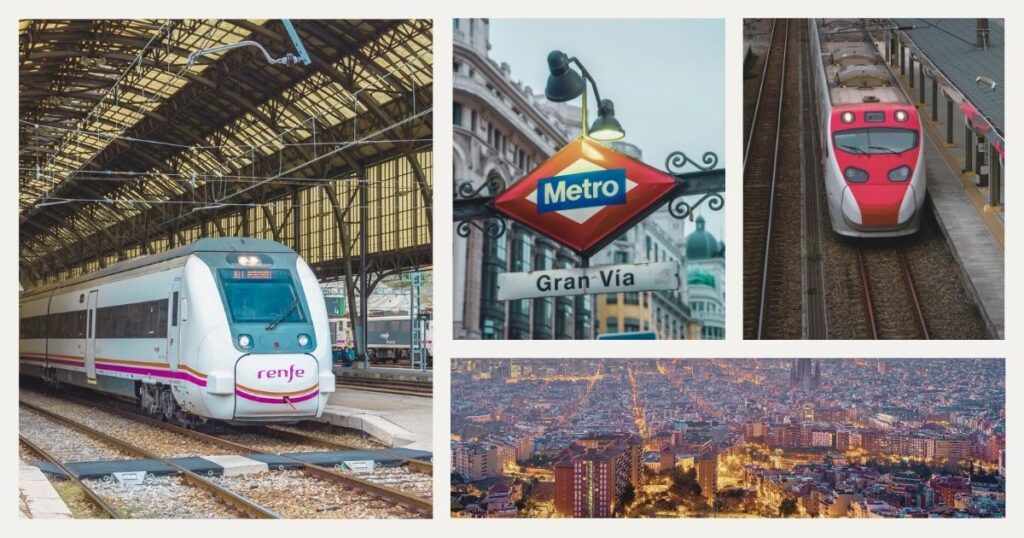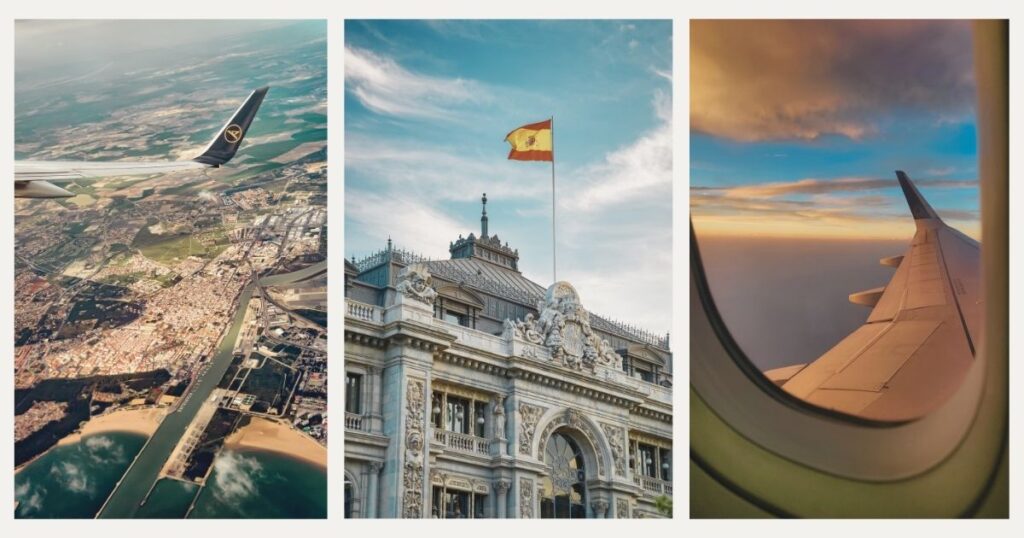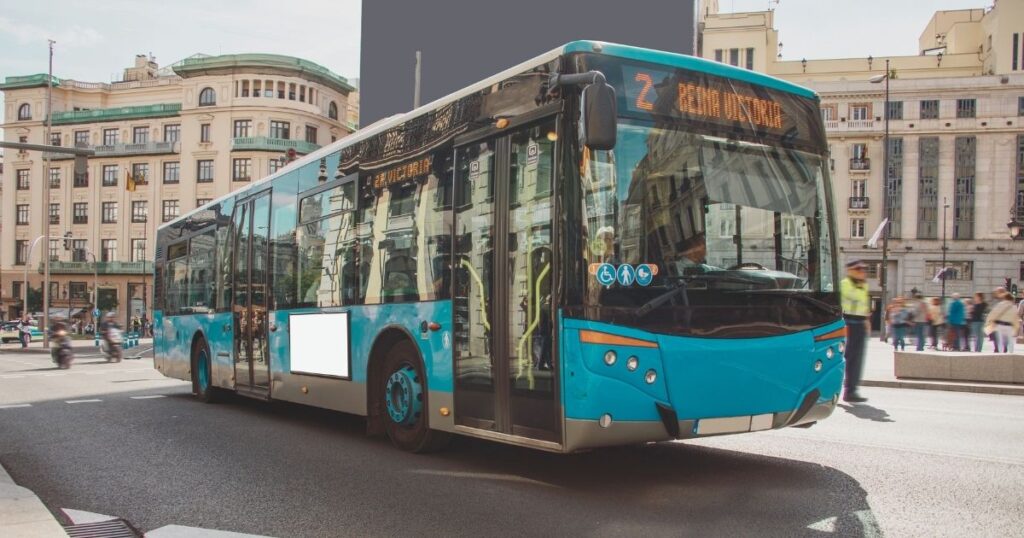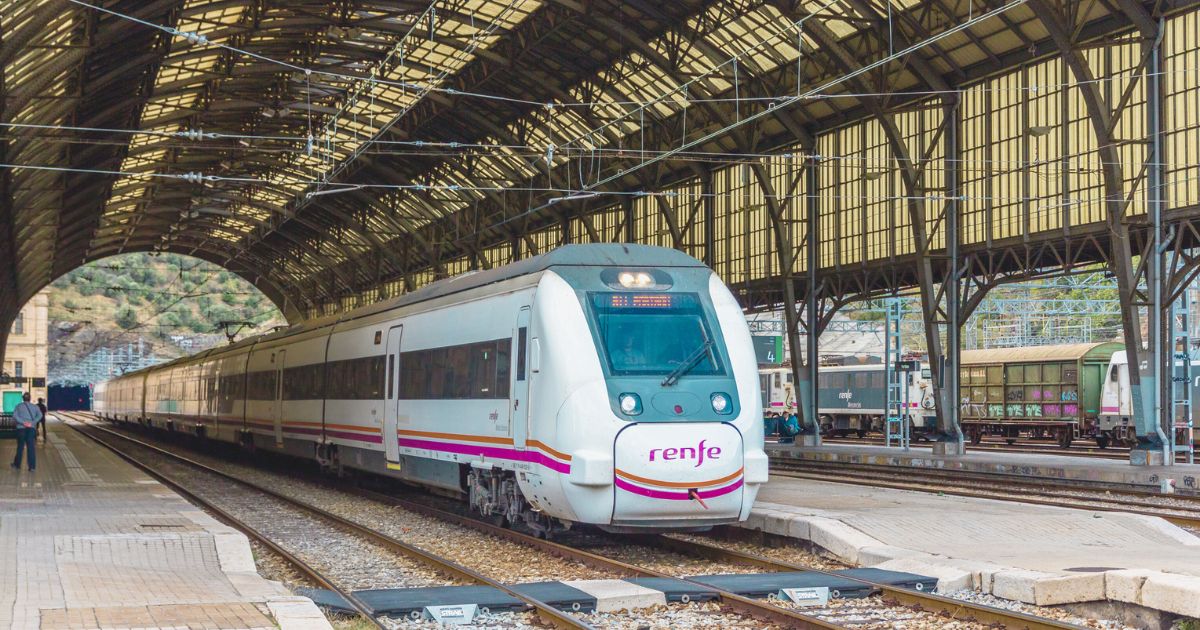Understanding how to get from Madrid to Barcelona opens up seamless travel between Spain’s two most dynamic cities. This popular route connects the political capital with Catalonia’s cultural heart, offering digital nomads multiple transportation options to suit different budgets, schedules, and preferences.
The 621-kilometer distance between Madrid and Barcelona provides travelers with excellent connectivity through Spain’s modern transportation infrastructure. Each method offers distinct advantages for different travel needs.
High-speed train: the premium choice

When considering how to get from Madrid to Barcelona efficiently, Spain’s high-speed rail network represents the gold standard for intercity travel. The AVE (Alta Velocidad Española) trains provide a perfect balance of speed, comfort, and convenience that appeals to business travelers and digital nomads alike.
AVE train service details
The AVE service tops the solutions for how to get from Madrid to Barcelona by rail, offering journey times of just 2 hours and 30 minutes between city centers. Trains operate from Madrid’s Atocha station to Barcelona’s Sants station, both excellently connected to metro networks and urban transportation systems.
Renfe operates up to 25 daily AVE services during peak periods, with departures approximately every 30 minutes during busy hours. The first train typically departs around 6:20 AM, while the last service leaves around 9:25 PM, providing excellent flexibility for various travel schedules.
All AVE trains feature air conditioning, power outlets at every seat, free Wi-Fi connectivity, and spacious seating that accommodates laptops and work materials. The smooth ride quality and minimal vibration make productive work possible throughout the journey, appealing to digital nomads who want to maximize their time efficiency.
Ticket classes and pricing
AVE trains offer multiple service classes when learning how to get from Madrid to Barcelona with different comfort levels. Turista (economy) provides comfortable seating with adequate legroom, while Turista Plus offers additional space and complimentary snacks. Preferente (business) includes premium seating, meal service, and lounge access.
Standard tickets typically range from €25-80 depending on booking timing and demand, with advance purchase often providing significant savings. Flexible tickets cost more but allow changes and cancellations, valuable for travelers with uncertain schedules. Peak travel times command premium pricing compared to mid-week departures.
Promotional fares occasionally reduce costs to as low as €15 for advance bookings during off-peak periods. Senior discounts, youth rates, and family packages provide additional savings opportunities for eligible travelers.
🌟 Pro tip: book AVE tickets 60 days in advance for the best prices, especially during Spanish holidays and summer months. The Renfe app allows easy mobile ticket management and provides real-time delay information for seamless travel planning.
Flight options: speed above all

Air travel provides the fastest option when determining how to get from Madrid to Barcelona, though the total journey time including airport procedures often makes trains more efficient for this domestic route. Multiple airlines serve this popular corridor with frequent departures throughout the day.
Airlines and flight frequency
Several carriers operate when you need to know how to get from Madrid to Barcelona by air. Iberia provides the most frequent service with up to 20 daily flights, offering excellent schedule flexibility throughout the day. Vueling and Air Europa also serve this route with competitive pricing and modern aircraft configurations.
Flight time averages just 1 hour and 20 minutes gate-to-gate, making it the shortest travel time option. However, recommended arrival times of 1-2 hours before domestic departures, plus travel time to and from airports, often extend total journey time to 4-5 hours when including check-in, security, and transportation procedures.
Madrid’s Barajas Airport and Barcelona’s El Prat Airport both offer excellent connectivity to their respective city centers via metro, bus, and taxi services, though these add time and cost compared to centrally located train stations.
Cost considerations
Flight prices fluctuate significantly when considering how to get from Madrid to Barcelona affordably. Budget airlines offer fares starting around €30 for advance bookings, while full-service carriers charge €60-150 depending on flexibility and timing. Last-minute bookings can exceed €200 during peak demand periods.
Tuesday and Wednesday departures typically offer lower fares compared to weekend travel, while early morning and late evening flights often cost less than midday departures. Baggage fees can add €15-30 to budget airline tickets, affecting total travel costs for travelers with extensive luggage.
Environmental considerations increasingly influence choices, as trains produce significantly lower carbon emissions per passenger compared to flights for this domestic route, making rail travel more sustainable despite similar total journey times.
💡 Did you know? The Madrid-Barcelona air route ranks among Europe’s busiest domestic corridors, with over 5 million passengers annually. This high demand ensures frequent departures but means advance booking becomes crucial during Spanish holidays and major events.
Bus travel: the budget-friendly alternative

Bus services provide the most economical option when learning how to get from Madrid to Barcelona on a tight budget. Several operators serve this route with modern, comfortable coaches equipped with amenities that make longer journey times more tolerable.
Bus companies and services
ALSA dominates bus service when considering how to get from Madrid to Barcelona by road. Their Supra and Premium services offer leather seating, extra legroom, Wi-Fi connectivity, and onboard entertainment systems. Standard services provide basic comfort at lower prices while maintaining reliability and safety standards.
Journey times typically range from 7-9 hours, depending on traffic conditions and routing. Night buses allow passengers to sleep during travel, effectively combining transportation and accommodation costs. Some services include meal stops or onboard catering, though many travelers prefer bringing their own refreshments.
FlixBus and other operators occasionally serve this route with competitive pricing targeting budget-conscious travelers and backpackers with basic amenities but reliable transportation.
Modern bus services address digital nomad needs with Wi-Fi connectivity for light work, though connection stability varies by operator and route conditions. Power outlets enable device charging, while comfortable seating and climate control make extended travel more pleasant. Rest stops every 2-3 hours provide opportunities to stretch and refresh.
🌟 Pro tip: choose aisle seats for easier movement and consider bringing a travel pillow for overnight journeys. Download offline entertainment and work materials before departure, as Wi-Fi quality can be inconsistent throughout the route.
Driving: maximum flexibility

Driving provides ultimate flexibility when planning how to get from Madrid to Barcelona with personal transportation needs. The well-maintained highway system offers scenic routes and the freedom to explore intermediate destinations along the way.
Route and driving conditions
The primary route when driving Madrid to Barcelona follows the A-2 highway through Zaragoza, covering approximately 621 kilometers. This modern autopista features excellent road conditions and regular service areas.
Driving time typically ranges from 6-7 hours under normal conditions, though traffic around major cities can extend journey times during peak hours. Alternative scenic routes through smaller towns add time but offer cultural experiences.
Costs and practical considerations
Fuel costs, tolls, and parking create the primary expenses when considering how to get from Madrid to Barcelona by car. Highway tolls typically total €25-35, while parking in Barcelona can cost €15-25 per day.
Car rental provides flexibility for travelers without personal vehicles, with daily rates starting around €20-40 plus insurance. For digital nomads staying connected during travel, consider reliable mobile data solutions like Holafly’s Spanish travel data plans to ensure navigation access throughout the journey.
Traffic conditions vary significantly by season. Summer holiday periods see increased congestion, while real-time traffic apps help optimize routing and timing for efficient travel.
Digital nomad and timing considerations

When planning how to get from Madrid to Barcelona as a digital nomad, connectivity and seasonal timing become important factors beyond basic transportation logistics.
Connectivity and equipment
Maintaining internet connectivity affects how to get from Madrid to Barcelona while meeting work obligations. Train travel offers the most reliable Wi-Fi connections, with AVE services providing consistent high-speed internet throughout the journey for video calls and file uploads.
Flight Wi-Fi services vary by airline, with domestic flights often lacking connectivity. Bus Wi-Fi quality varies significantly, while connection speeds may not support video conferencing. Planning offline work activities becomes essential for productive bus travel.
Transportation choice affects equipment management. Trains offer generous baggage allowances and easy handling, while airlines impose strict limits that may require checked baggage for extensive equipment. Bus services generally allow reasonable luggage amounts but may restrict oversized items.
Seasonal timing and pricing
Summer months (June-August) present challenges when learning how to get from Madrid to Barcelona during peak season. Transportation prices increase significantly, with train tickets often doubling compared to off-season rates.
Spanish holiday periods create additional demand spikes. Advance booking becomes essential during these periods, as popular departure times often sell out. Mid-week travel (Tuesday-Thursday) generally costs less than weekend departures across all transportation modes.
Early morning departures often provide better pricing and punctual service. This flexibility particularly benefits digital nomads who can adjust schedules to optimize travel costs while avoiding crowds.
💡 Did you know? Spain’s high-speed rail network ranks among the world’s most extensive, with over 3,100 kilometers of track. The Madrid-Barcelona route was among the first completed, establishing the standard for Spanish rail development.
Final thoughts on Madrid to Barcelona travel
Understanding how to get from Madrid to Barcelona empowers travelers to choose the most suitable option based on their priorities, whether emphasizing speed, cost, comfort, or flexibility. High-speed rail offers the optimal balance for most travelers, while flights serve those prioritizing absolute speed and buses appeal to budget-conscious adventurers.
The route’s excellent connectivity ensures reliable options throughout the year, though seasonal planning optimizes both pricing and experience quality. Digital nomads benefit from Spain’s modern infrastructure and growing remote work acceptance in both cities, making either destination attractive for extended stays or location-independent work.
Ready to explore the dynamic route between Spain’s two greatest cities? Whether you choose the efficiency of high-speed rail or the flexibility of other options, both Madrid and Barcelona offer incredible opportunities for digital nomads and travelers alike. Let Nomada help you make the most of your Spanish adventures!
Frequently asked questions about getting from Madrid to Barcelona
Flying provides the shortest travel time at 1 hour 20 minutes, but including airport procedures, the total journey often takes 4-5 hours. High-speed trains take 2 hours 30 minutes city center to city center, making them effectively faster for most travelers when considering all procedures and transportation to/from airports.
Costs vary significantly by transportation mode and booking timing. Train tickets range from €25-80, flights cost €30-200, and buses start around €15-40. Driving costs approximately €50-70 including fuel and tolls, plus car rental if needed. Advance booking typically provides substantial savings across all options.
High-speed trains provide the most reliable Wi-Fi connectivity, allowing video calls and bandwidth-intensive work throughout the journey. Flight Wi-Fi varies by airline, while bus connectivity can be inconsistent. Train travel offers the best combination of reliable internet and comfortable workspace conditions.
Driving makes sense for travelers planning stops along the route, needing personal transportation in Barcelona, or traveling with extensive luggage. The journey takes 6-7 hours plus costs for fuel, tolls, and parking. For direct travel between city centers, trains typically offer better value and convenience.
Book train tickets up to 60 days in advance for optimal pricing, especially during Spanish holidays. Flight prices fluctuate more, but 2-4 weeks advance booking usually provides good rates. Mid-week travel and off-peak seasons offer the best combinations of pricing and availability across all transportation modes.

